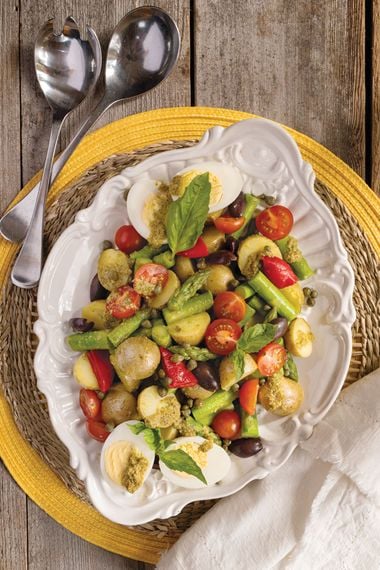Asparagus Niçoise with Pesto Dressing
- Prep10 mins
- Cook20 mins
- Total30 mins
- Servings4
- Ingredients9

Typically a composed salad, Niçoise also works as a toss-ahead option for people who live for texture in their salad bowl. With spring-fresh asparagus, tender new potatoes, sweet-fiery Peppadew peppers, and a punchy pesto dressing, it’s a salad to look forward to all day long. For your protein, you could swap out the egg for chunks of high quality canned tuna. Look for Peppadews in the deli section of grocers, but if unavailable you can use roasted red peppers.
Full steam ahead
Boil your eggs and you risk rubbery whites, chalky green-tinged yolks, and clingy shells, giving you cooked eggs that look like they’ve been in the path of a meteor shower. Your hack for perfect hard-boiled eggs every time is to give the orbs a steam bath—yolks will remain creamy and sunnier than a Caribbean vacation, while shells will effortlessly slide off the just-set whites.
Starch madness
When cooked and then cooled for several hours, the digestible amylopectin starches in potatoes convert into the hardened resistant starch amylose. Resistant starch is digested by the micro-bugs in your colon, so it acts as a prebiotic. This means that beneficial bacteria feed on it, increasing their population numbers to improve the gut microbiome, which, in turn, may benefit your digestive and immune health.
Asparagus Niçoise with Pesto Dressing
- Prep10 mins
- Cook20 mins
- Total30 mins
- Servings4
- Ingredients9
Ingredients
- 4 large organic eggs
- 1 lb (450 g) baby “new” potatoes
- 1 bunch asparagus, woody ends trimmed and cut into 2 inch (5 cm) pieces
- 2 cups (500 mL) cherry tomatoes, halved
- 1 cup (250 mL) Peppadew peppers, halved
- 1/3 cup (80 mL) halved Niçoise or Kalamata olives
- 1 Tbsp (15 mL) capers, drained
- 1/4 cup (60 mL) prepared basil pesto
- 2 Tbsp (30 mL) red wine vinegar
Nutrition
Per serving:
- calories315
- protein13g
- fat14g
- saturated fat3g
- trans fat0g
- carbohydrates36g
- sugars11g
- fibre8g
- sodium427mg
Directions
01
In medium saucepan, bring 1 in (2.5 cm) water to a boil. Add steamer basket to pan and place eggs in basket in a single layer. In medium bowl, place ice cubes and water. Steam eggs for 15 minutes and then immediately transfer eggs into bowl filled with ice water. Let rest for 20 minutes. Gently break shells in a few places and then start peeling from the bottom end where there is an air pocket. Slice eggs in half.
02
In large pot of cold water, place potatoes and then bring to a boil. Add 1 tsp (5 mL) salt to boiling water and boil potatoes, with lid ajar, for 10 to 15 minutes, just until potatoes are fork-tender.
03
With slotted spoon, remove potatoes from pot and set aside in colander to drain. In medium bowl, place ice cubes and water. Add asparagus to pot and simmer until bright green and tender, about 3 minutes. Remove asparagus from water and immediately place in ice bath to stop the cooking. Drain well.
04
Slice cooked and cooled potatoes in half. In large bowl, add potatoes, asparagus, tomatoes, Peppadew peppers, olives, and capers; gently toss everything together. Stir together pesto and red wine vinegar. Toss with salad. Tuck in halved eggs and serve.





